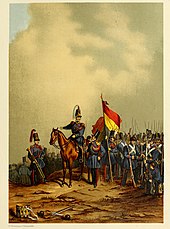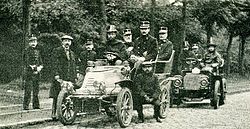Garde Civique

TheGarde CiviqueorBurgerwacht(FrenchandDutch;"Civic Guard" ) was aBelgianparamilitarymilitiawhich existed between 1830 and 1920. Created in October 1830 shortly after theBelgian Revolution,the Guard amalgamated the various militia groups which had been created by the middle classes to protect property during the political uncertainty. Its role was as a quasi-military "gendarmerie",with the primary role of maintaining social order within Belgium. Increasingly anachronistic, it was demobilised in 1914 and officially disbanded in 1920, following a disappointing performance during theGerman invasion of BelgiuminWorld War I.
Organisation[edit]
TheGardewas organized at a local level, originally in all communes with more than 30,000 inhabitants. Subsequently this "constitutional force" was limited to those towns having a population of 10,000 or more. More thinly populated communities did not have this obligation unless subject to special legislation.[1]
It was composed of citizens aged between 21 and 50 who did not already have military obligations as serving soldiers or reservists. Those aged between 21 and 32 were required to undertake training ten times annually, while the second class (aged 33–50) were obliged only to register their addresses at regular intervals. A third class was composed of older volunteers, who were not equipped, uniformed or armed and were expected only to provide support functions in their local regions. TheGarde Civiquewas, in peacetime, the responsibility of the Ministry of the Interior rather than the Ministry of War.[2]It was distinct from theBelgian Gendarmerie(Rijkswacht) which formed part of the military.[3]

Most of theGardeunits were infantry but there were some artillery and mounted detachments. On the eve of World War I theGarde Civiqueincluded 33 companies ofchasseurs-à-pied(light infantry), 17 batteries of artillery, 4 squadrons ofchasseurs-à-cheval(light horse) and 3 companies ofsapeurs-pompiers(armed firemen). About half of these special corps were concentrated in the urban areas of Brussels, Antwerp, Ghent and Liège, reflecting the historic role of theGardeas a force to maintain civil order.[4]
The mounted component of theGarde Civiquewere retained primarily for ceremonial purposes and were armed only with sabres and revolvers. The Liège Company of thechasseurs-à-chevalwere however issued withcarbinesat the time of the German invasion in August 1914 and served as infantry in defence of the city.[5]
Purpose[edit]
The stated purpose of theGardewas to maintain order and preserve the independence and integrity of Belgium.[6]It was anticipated that in the event of invasion the Civic Guard would be mobilised as part of the national defence, upon the passing of legislation by parliament.[7]
During the 19th century these "civic soldiers" had frequently been employed to control strikes or disorders. Membership in infantry units located in urban areas was in principle obligatory for adult men who could afford their own uniforms and had not served in the regular army. The more prestigious cavalry and artillery units were made up of volunteers, usually from affluent classes.[8]
Uniform and equipment[edit]
Each regional unit of theGardehad its own dark blue or green uniform, generally following the pattern of those worn by the regular army but with a number of variations.[9]Infantry wore a wide brimmed hat with plume, cavalry a furbusbyand artillery ashako.[10]Officers followed the same system of ranks and insignia as the army but traditionally substituted silver braiding and badges for the gold/bronze of the regulars.[11]
The 40,700 civil guardsmen serving in the active portion ( "1st Ban" ) of the force were required to provide their own uniforms.[12]Weapons, leather equipment and items such as drums and bugles were all issued from central stocks held by the Ministry of the Interior.[13]
Role in World War I[edit]

TheGarde Civiquewere mobilised following the German invasion of Belgium on 4 August 1914. Their intended functions were to secure lines of communication, guard bridges and other installations, escort prisoners and maintain order outside the actual areas of combat. The German military authorities however chose to regard members of theGardeasfranc-tireurs(irregulars) and, as such, not under the protection of international law if taken prisoner. Demands were made that they be disarmed and disbanded. In view of the German shooting of Belgian civilian hostages during the early stages of the invasion such threats were taken seriously and on 13 October 1914King Albert Idecreed the dissolution of theGarde.[14]Most of its younger members transferred to the regular Belgian Army.
The German threat to execute captured members of theGardewas not in the event acted on. While a number were held in prisoner of war camps all had been released by 1915.[15]
Final disbandment[edit]
Upon entering liberated Belgium territory in October 1918, King Albert was reportedly met by a saluting veteran of theGarde Civiquein full-dress uniform who had kept his equipment and rifle hidden during the four years ofGerman occupation.[citation needed]Such incidents could not however avoid the reality that theGardehad proven to be of limited military use and was no longer required for the role of ensuring social order that had been its prime purpose during the 19th century. The force was accordingly formally disbanded in 1920.
See also[edit]
- Gendarmerie(Rijkswacht), a military police force in Belgium active from 1830 and disbanded in 1992.
- Force Publique,a comparable quasi-military police force inCongo Free StateandBelgian Congo.
References[edit]
- ^Page 50 "Handbook of the Belgian Army", British War Office 1914,ISBN978-1-78331-094-4
- ^Courcelle, Pawly R. & Lierneux P. (2009).The Belgian Army in World War I(1. publ. ed.). Oxford: Osprey. p.7.ISBN9781846034480.
- ^Lierneux, Pierre (2017).The Belgian Army in the Great War Vol. 2(1. ed.). Vienna: Verlag Militeria. p. 170.ISBN978-3-902526-86-1.
- ^Page 52 "Handbook of the Belgian Army", British War Office 1914,ISBN978-1-78331-094-4
- ^Lierneux, Pierre (2017).The Belgian Army in the Great War Vol. 2(1. ed.). Vienna: Verlag Militeria. p. 54.ISBN978-3-902526-86-1.
- ^Page 51 "Handbook of the Belgian Army", British War Office 1914,ISBN978-1-78331-094-4
- ^Pawly, R; Lierneux, P. (2009).The Belgian Army in World War I(1st ed.). Oxford: Osprey. p. 184.ISBN978-1-84603-448-0.
- ^Pawly, R; Lierneux, P. (2009).The Belgian Army in World War I(1st ed.). Oxford: Osprey. pp. 184–185.ISBN978-1-84603-448-0.
- ^Aug. Bernard,La Garde Civique belge et ses origins,Liege 1905[page needed]
- ^Colour plates by Louis Geens, published in Issues 65 and 66 of "Tradition - the Journal of the International Society of Military Collectors"
- ^Pawly, R; Lierneux, P. (2009).The Belgian Army in World War I(1st ed.). Oxford: Osprey. p. 187.ISBN978-1-84603-448-0.
- ^Page 51 "Handbook of the Belgian Army", British War Office 1914,ISBN978-1-78331-094-4
- ^Pawly, R; Lierneux, P. (2009).The Belgian Army in World War I(1st ed.). Oxford: Osprey. p. 187.ISBN978-1-84603-448-0.
- ^Pawly, R; Lierneux, P. (2009).The Belgian Army in World War I(1st ed.). Oxford: Osprey. p.7.ISBN978-1-84603-448-0.
- ^Pawly, R; Lierneux, P. (2009).The Belgian Army in World War I(1st ed.). Oxford: Osprey. p. 186.ISBN978-1-84603-448-0.
Further reading[edit]
- Leclercq, Pierre (2005).Histoire de la Garde Civique.Brussels: Labor.ISBN9782804020224.
External links[edit]
- Garde Civiqueat 1914-1918 Online: International Encyclopedia of the First World War
- 1830 establishments in Belgium
- 1920 disestablishments in Belgium
- Defunct law enforcement agencies of Belgium
- Military units and formations of Belgium in World War I
- Military units and formations of Belgium
- Defunct gendarmeries
- Military units and formations established in 1830
- Military units and formations disestablished in 1920
